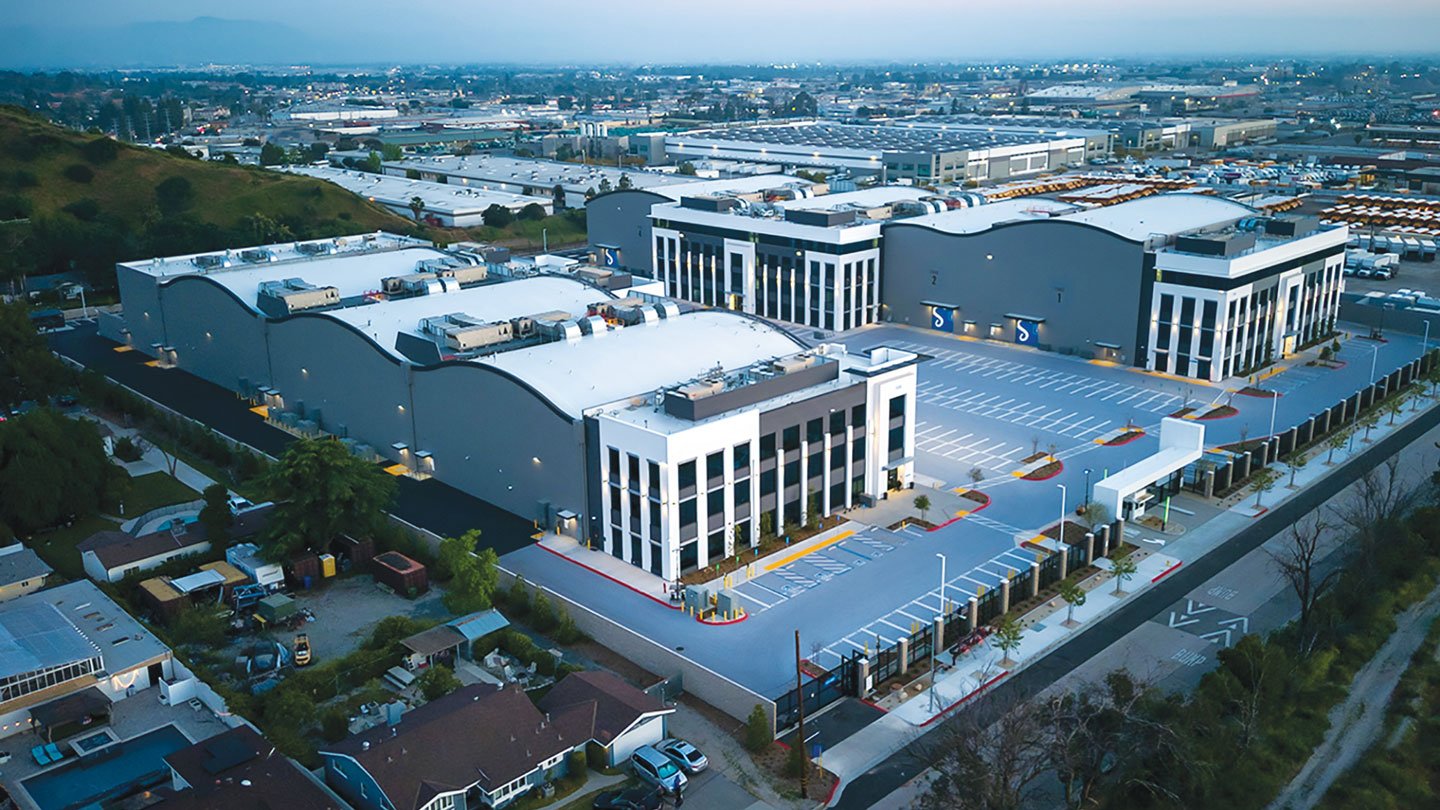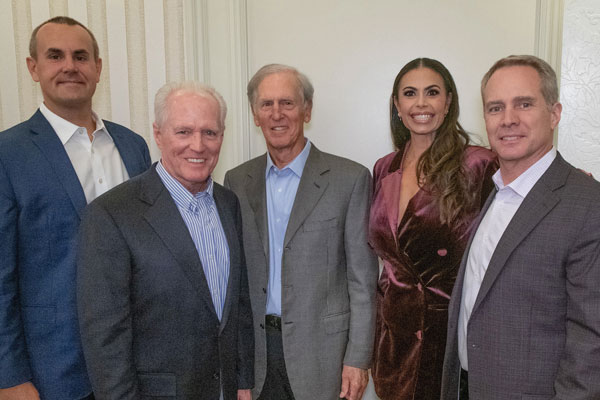
Succession Planning Preserves a Legacy
Snyder Langston’s transition to a new executive leadership team followed a 10-year timeline.
In 2023, when Jason Rich assumed the role of CEO at Snyder Langston, one of Southern California’s top master builders, it marked the culmination of a succession plan years in the making. The carefully crafted strategy ensured a smooth transition for the firm’s leadership team, now led by Rich, President and Chief Operating Officer Lee Watkins, and Chief Relationship Officer Jo-E Lopez.

From left, Lee Watkins, John Rochford, Stephen Jones, Jo-E Lopez and Jason Rich. Photo courtesy of Snyder Langston
The journey began a decade prior, as senior leaders John Rochford, then-president, and Stephen Jones, chairman, faced retirement and initiated a critical discussion about the company’s future. Observing the fate of competitors who had failed to prepare for leadership transitions, Rochford and Jones recognized the consequences of neglecting succession planning: diminished legacies, talent attrition and, eventually, a sale or hasty merger of the business.
Determined to avoid such pitfalls, the duo explored options including an employee stock ownership plan, going public or a strategic merger with another entity. Ultimately, they resolved to preserve the legacy established by company founders Don Snyder and Bill Langston in 1959. They would take a path to ensure the transfer of power would be done with purpose, setting up the new generation for success. As Rochford noted, “Steve and I discussed an internal transfer, like Bill did with us, but determined that we’d have to do it differently.”
Building a Thoughtful Succession Framework
Key considerations for Rochford and Jones included structuring financial arrangements for the new leaders, accommodating industry changes, and selecting successors who embodied the company’s culture. The pair initially engaged external consultants, but their recommendations, which included selling or merging, were limited and didn’t align with the vision of maintaining control and independence. Ultimately, Rochford and Jones assumed responsibility for crafting the plan.
Rochford knew the plan had to be deliberate in its structure. A 10-year timeline was established to accommodate Rochford’s and Jones’ staggered retirements while ensuring the company’s financial and operational stability. The plan had to set an exit price for the departing owners while establishing the company’s equity needs to continue operations, including bonding. Rochford also looked at future growth, considering recessions and other economic cycles. The decade-long time frame was a logical way to transfer leadership and set up the capital the company needed for the long term.
“A unique aspect of the construction industry is that it takes a few years to design, develop and build a project,” Rochford said. “When peers would tell me they brought in a CEO and gave them a year to train, I would say, ‘Good luck.’ How can anyone learn the existing book of business, adapt to an existing culture and develop true followership in one year? Chances are they won’t. They will do things their own way, spurring internal dissension.”
The longer time frame also proved invaluable for navigating unforeseen challenges such as the COVID-19 pandemic.
Selecting Leaders for the Next Era
Choosing the right leaders to carry the firm forward with an understanding of how the industry is changing was a deliberate and thoughtful process. “The era that Steve and I grew up in lacked empathy,” Rochford said. “It was a ‘no excuses, get back to work’ mentality. But that’s not today’s industry, and we have worked hard to foster a culture within Snyder Langston that best serves our people and clients.”
At its inception, Snyder Langston committed to establishing a culture as a “trusted advisor.” One of the culture’s guiding principles is that the trusted advisor will place a higher value on maintaining and preserving the relationship itself — with clients, architects, subcontractors and public officials — than on the outcomes of the current transaction, financial or otherwise. “It was how Bill Langston did business, and I knew it was what we needed to focus on to carry our legacy forward,” Rochford said. That approach to business drove the decision-making regarding who would lead Snyder Langston.
Rich, who joined the firm in 2002, was selected as CEO for his work ethic, his character and his ability to empathize with others. “The culture of Snyder Langston is about creating success for both our employees and the client,” Rich said. “Steve and John put the longevity of the company and the client relationship above everything and applied that same principle to our transition.”
Recognizing the importance of diverse perspectives and leadership styles, Rochford and Jones appointed Lopez as chief relationship officer. With the firm since 2006, Lopez’s role underscores the priority Snyder Langston places on cultivating and preserving relationships. “Steve and John were very purposeful about putting me in the position that they did. Relationships are fundamental to the organization. Having someone responsible for overseeing those relationships is a true testament to what makes Snyder Langston different,” Lopez said.
Finally, Jones and Rochford considered the breadth of the firm’s service lines. Watkins, who joined in 2013, was named president/COO. With a passion for health care and behavioral health, Watkins is dedicated to fostering operational excellence across teams while offering strategic insights to drive growth in the firm’s key sectors.
While Jones and Rochford initially designed the 10-year succession plan to accommodate the financial demands of an internal transfer, it created a beneficial training structure for the trio. “As you grow your career in construction, the things you do to be a good builder are not necessarily the same things that will make you a good business owner,” Watkins said. “You don’t appreciate all the facets that go into a company when you’re out in the field delivering projects. The 10-year vision gave us time to learn the business and develop followership in the company. Plus, when we stepped into our roles, we didn’t skip a beat because we’d been shadowing John and Steve for a decade.”
“Many organizations don’t transition well,” Lopez added. “However, Steve and John were mindful of mentoring and training, holding us accountable and putting us in positions to test our boundaries and limits.”
Navigating a Leadership Crucible
Under the leadership of Jones and Rochford, Snyder Langston had weathered the storm of the 2008 financial crisis. They decided the COVID-19 pandemic could serve as a crucible of leadership for Rich, testing the soon-to-be CEO’s resilience and adaptability.
Rochford told Rich, “You lead the company, and I will watch. If you need help, I’m here. Otherwise, you call the shots.”
Rochford knew if Rich was successful, the organization and its clients would see him as the leader, allowing for an even smoother transition.
Rich dealt with everything from a full industry shutdown to construction being singled out as an essential business, all while juggling changing requirements from federal, state and local levels for Snyder Langston’s worksites and people. Rochford had Rich make the decisions and communicate those decisions to the company and its clients.
“Did I agree with all the decisions? Maybe not, but that was part of the learning experience,” Rochford said. “That is the crucible. You can’t simulate or teach navigating Black Swan events like COVID-19, and Jason did a remarkable job.”
Added Lopez, “I saw a dramatic change. As a leader, Jason was very methodical and steady, but COVID forced him to make decisions quickly with limited information. That made him a stronger leader.”
A Vision for the Future
Rochford retired at the end of 2024, capping Snyder Langston’s 10-year succession plan and officially transitioning the company to a new executive leadership team.
“Our responsibility is to build upon the legacy, constantly improving while maintaining the core values that define us,” Rich said. “That is my challenge as CEO and as the leader of this generation for Snyder Langston.”
Looking ahead, Rich, Lopez and Watkins are prioritizing opportunities for career growth, inspired by their own succession experience. They are already preparing to mentor the next generation of leaders, ensuring Snyder Langston’s legacy continues for decades to come.
Jessica Spaulding is president of the Spaulding Agency.
|
Access the NAIOP Research Foundation’s May 2025 report, “Succession Planning for Commercial Real Estate Firms,” at naiop.org/research-and-publications. |




